Aug 31, 2021
DOCK SWAY BRACE
Is a sway brace used on your dock? If not, does your dock sway as you walk on it? There are several reasons this can happen to any dock or pier.
There are main TWO reasons for dock movement.
You need to distinguish between the two types of movement. Is it an up and down movement, or is it a side to side movement?
First, Let’s tackle the Up and Down movement.
When installed, PWS makes sure the legs are firmly on the bottom. This typically makes the dock stable for most people.
Yet, over time, storms can wash out or move the sand or rocks under the footpads. Sand is more susceptible to this action.
It’s the same effect that erosion has on the shoreline. First, it washes away sand and small stones from under the footpad. Then, it continues to work on the remaining stones and rocks. When enough materials are removed, there is nothing left to support the leg.
At this point, you may experience the sensation of up and down movement as you walk.
How do we prevent it from happening?
There is no way to completely prevent washing out of the footpads. If we disturb the lake bottom too much, it weakens the tightly packed base. Disturbing the lake bottom makes it easier for the wave action to wash the sand away. The sand (or small stones) are loosely packed and have small openings in them.
The only “cure” is to reset the legs firmly on the bottom. We notice this frequently occurs after strong storms. The “white caps” you see are moving the water under the surface also.
The second type of movement is actual “sway.”
“Sway” is the side-to-side movement when the dock is set higher above the water.
The current water level is still above average even though it is down from 2019 and 2020. This is evidenced by the continued erosion happening up and down the shoreline.
PWS raises your dock up to protect it from high wave action during the summer. When the frames are adjusted higher, the pier becomes less stable. Walking on the dock will cause a side-to-side movement because the center of gravity is higher.
Think of a simple fishing pole. When the pole moves at the bottom, the movement is amplified at the top of the pole. The higher the frames are raised, the more side movement will occur.
See this link for more information.
There is a solution.
A sway brace on the legs reduces the sway side sway. You’ll feel more secure as you walk the length of your dock.
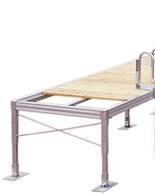
Sway Brace
Does every set of legs need sway braces?
No. PWS will make recommendations based on the heights and lengths of your dock or pier. Often, we add a single brace on a pair of legs. Next, we alternate the position in the opposite direction on the next set of legs.
One brace is attached near the bottom of one leg and clamped higher up on the opposite leg. This depends on the height of the legs.
It may involve a crew member having to submerge in the water to reach the bottom of the leg. In spring, that is not something anyone wants to do.
Does it matter if I have an aluminum or steel frame?
A steel frame is less likely to need braces than an aluminum frame due to its own weight. Different configurations are available for aluminum frames, but the principle is the same.
Braces are available for new installations, as shown here. There is an add-on version (independent components) for existing frames. They can be added to existing dock legs if needed. Either version will help stabilize your dock in deeper water.
Will sway braces help your dock?
Call Jerry at 920-493-4404 for more details.
Where is Pier & Waterfront Solutions?
Located at 7325 St. Hwy 57, it’s 3 miles south of Sturgeon Bay and 1 mile past the intersection of Cty MM (heading north). Look on the right side, one mile north, at the next corner (Idlewild Road and Hwy 57).
Is PWS OPEN?
Pier & Waterfront Solutions remains “open.” We have implemented measures to help ensure the safety of our employees and visitors. PWS continues to work to maintain the trusted service that you have come to expect.
PWS implemented these preventive measures:
1. Conducting as much business as possible by email, text, or phone.
2. Site visits will continue. When in-person contacts are necessary, we will follow “social distancing” guidelines.
3. Our display yard is always open for you to examine at your leisure. All displays have a numbered, red tag on them. If you want more information or pricing, please reference that number.
What can YOU do to help us?
1. Please conduct as much business as possible via emails, messaging, and emails. This step protects everyone involved.
2. When you see our crews installing equipment, please practice “social distancing.” Remain at a safe distance.
Thank you for allowing us to work with you.
YES – PWS is OPEN and waiting for you!
Please call, message, or email PWS with any questions.
Let’s all stay safe!
Aug 19, 2021
Thanks for the prompt help with our dock. Looks Great. Guys were very efficient. Hope to continue your services going forward.
Jim G. Door County
Aug 5, 2021
Thanks so much Jerry. Your Customer Service is unparalleled!
Carter R. Door County
Jul 27, 2021
COMPARE A JUMBO JET TO OPEN DECKING
You’ve flown. Whether it’s 100 or 1,000 miles, it’s the same principle.
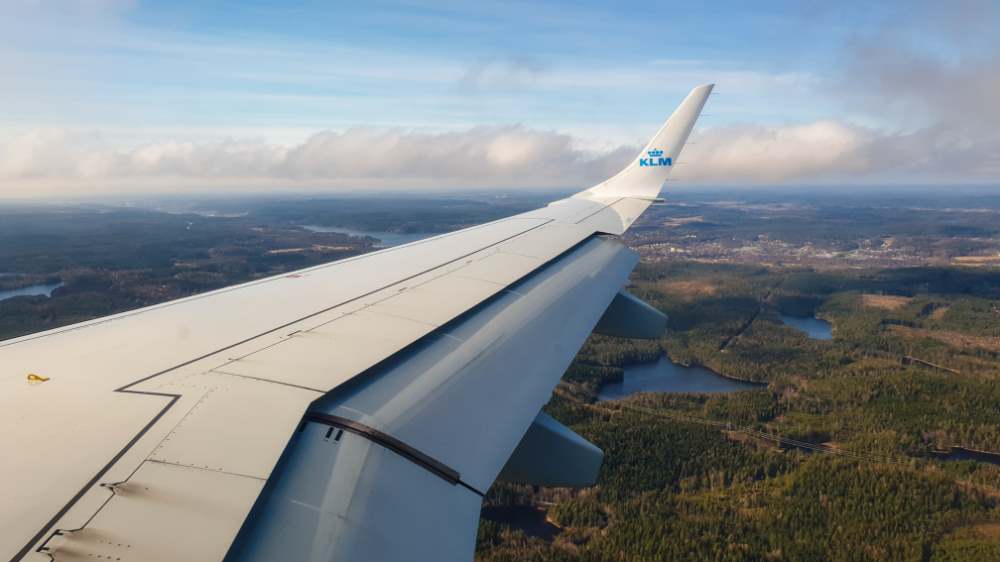
Airplane Flaps
Credit: Miguel Ángel Sanz
While landing at 125 MPH, a plane uses its “flaps” to provide extra “lift” when the forward speed is insufficient to keep the aircraft in the air. Flaps are those pieces of metal that roll out of the wing to slow the plane down while providing extra lift.
The added “lift” caused by the extended “flaps” maintains enough “lift” and surface area to keep the plane flying for a controlled landing.
What if the flap resistance was reduced to less than 60%?
What would happen if the flaps had “holes” in them. If you reduced the surface area by over 40%, what would happen? The answer is simple – the plane would soon be a pile of scrap metal.
By reducing the surface area of the flaps, air would pass right through, and the “lift” the pilot needed to stay airborne would disappear.
A plane needs the flaps’ resistance to help slow the aircraft when landing to maintain control.
The idea of resistance against the flaps works great for an airplane – not so much for your dock.
What has that got to do with open decking?
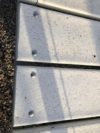
Typical Plank decking
That same principle of “lift” applies to your dock. Older docks have wood, aluminum, or plastic board decking. Despite the 1/2″ opening between the deck pieces, the decking is essentially a solid mass. When a wave comes up under the decking, the water tries to push the decking up.
Here’s where you have a choice.
With bolted-down decking, the wave is trying to lift the entire structure.
If you leave the decking loose, you risk losing that piece(s) of decking. Sometimes the pieces float a short distance and sink. You can recover them with a bit of effort.
The other side of the coin is they float too far away, and you end up purchasing new pieces.
What about “open decking”?
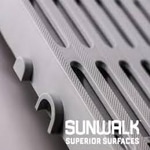
Open Decking
The open decking is like the “flaps” with holes in them. There is so much less surface area- 42% less – that the “lift” pressure is greatly reduced. The likelihood of lifting or flipping your dock over is significantly reduced.
We have to salvage many of the bolted down, solid plastic docks when the end lifts up and flips over. Usually, this causes the entire pier to flip over.
It’s like a train where the lead cars go off the track. Because they are connected to the next car, they all (or mostly all) flip over. The same is true with a dock.
You end up with twisted frames, which are a complete loss.
Is open decking hot to walk on?
No, for the same reason they are less likely to “lift” the dock. Those holes or slots rapidly dissipate the heat. The air passes through them and takes the heat away.
Does it get slippery when wet?
The shape of the slots allows the water to run off. The decking does not get “cupped,” which holds the water like the solid plastic boards. Besides, there are dimples on the walking surface to add traction.
It looks hard to walk on.
No, most people find open decking comfortable to walk or lay on.
Summary
Besides all the benefits noted above, the open decking costs LESS than other types of decking. These benefits are yours when you buy open decking from PWS.
Now pair these benefits with the PWS 3-Season Pier, and you have the best value for your money.
Call Jerry today. (920-493-4404) or jerry@wisconsinpws.com
Tell Your Friends & Family
Have friends or neighbors you believe should see this article? Email them this link – and Thank you!
Visit Pier & Waterfront Solutions on Facebook.
Where is Pier & Waterfront Solutions?
Located at 7325 St. Hwy 57, it’s 3 miles south of Sturgeon Bay and 1 mile past the intersection of Cty MM (heading north). Look on the right side, one mile north, at the next corner (Idlewild Road and Hwy 57).
Is PWS OPEN?
Pier & Waterfront Solutions has remained “open.” We have implemented measures to ensure the safety of our employees and visitors. At the same time, we are working to maintain the trusted service that you have come to expect.
PWS implemented these precautionary measures:
1. Conducting as much business as possible by email, text, or phone.
2. Site visits will continue. When in-person contacts are necessary, we will follow “social distancing” guidelines.
3. Our display yard is always open for you to examine at your leisure. All displays have a numbered, red tag on them. If you want more information or pricing, please reference that number.
What can YOU do to help us?
1. Please conduct as much business as possible via emails, messaging, and emails. This step protects everyone involved.
2. When you see our crews installing equipment, please practice “social distancing.”
Thank you for allowing us to work with you.
YES – PWS is OPEN and waiting for you!
Please call, message, or email PWS with any questions.
Let’s all stay safe!
Jul 13, 2021
BASKETBALL HOOP & WATER-SLIDE

Announcing ……….
A basketball hoop and a slide are some of the latest additions to the ShoreMaster line of accessories.
Take the game off the court and put it in the cool water. Everyone will enjoy a Basketball Hoop from ShoreMaster!
Imagine the summer fun your family will enjoy.
Basketball Hoop Details
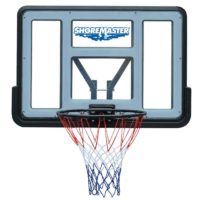
ShoreMaster Dockside Basketball Hoop
The backboard measures 44″ x 30″ for easy bank shots. Like most ShoreMaster dock accessories, the Dockside Basketball hoop utilizes the exclusive Infinity Track accessory system. You can easily attach and reattach it anywhere along the perimeter of the dock system. For more information on the Infinity track system, see this article.
The basketball hoop includes a 5′ post, which mounts easily to the side of the dock. (Non-ShoreMaster docks may require a simple adaptor plate.)
The hoop features an 18″ diameter rim, with waterproof nylon net, this basketball hoop is sure to provide years of fun.
Imagine your family having one more attraction this summer to keep them occupied. There is no reason to get bored in Door County.
SPECIAL NOTE – The Slide mentioned here is ONLY available for delivery in the Spring, 2022! The supplier is completely sold out and will only take our orders in the November pre-season order. Call Jerry today for pricing and get your Slide ordered for Spring, 2022.
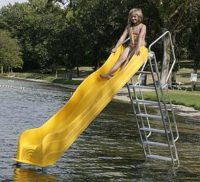
Free Standing slide
Another accessory is the Dock Mounted Slide shown here. This accessory will be a great addition to your dock. The slide can also be a freestanding unit in the water* or mounted on a dock.
Call Jerry @ (920) 493-4404 for details and pricing.
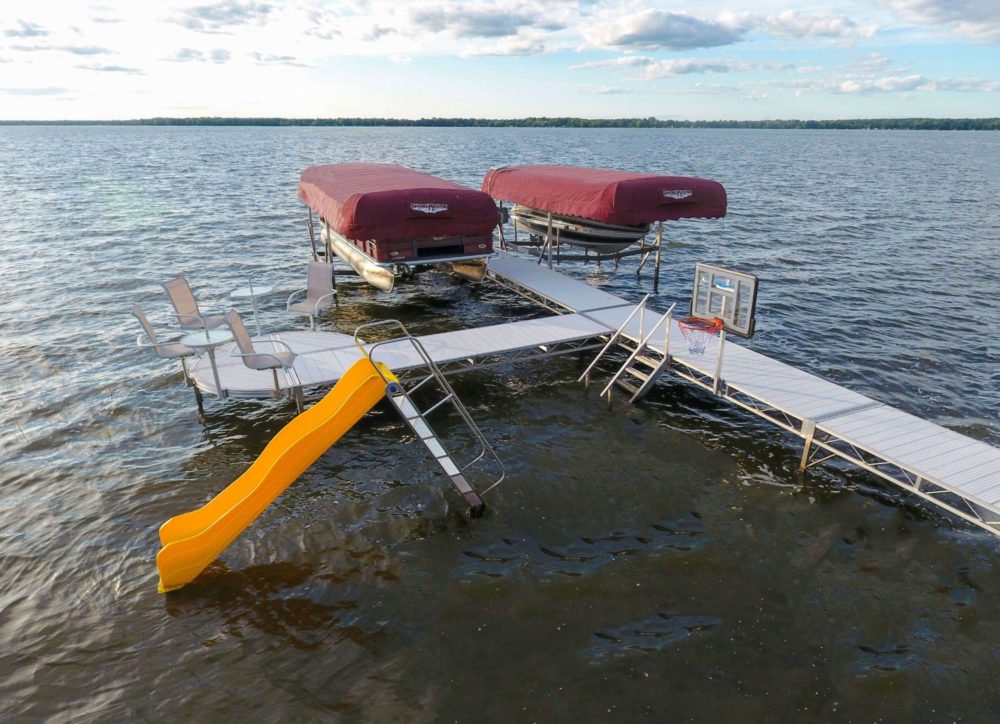
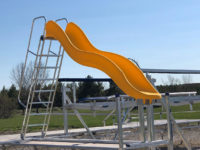
Dock Mounted slide
*Caution: Be sure the water depth is sufficient for the slide. We also recommend not going down head-first. Small children should use a life preserver as an added safety measure.
Tell Your Friends & Family
Have friends or neighbors you believe should see this article? Email them this link – and Thank you!
Visit Pier & Waterfront Solutions on Facebook.
Don’t Forget – Considering rip-rap for your shoreline? PWS is the place to contact!
Where is Pier & Waterfront Solutions?
Located at 7325 St. Hwy 57, it’s 3 miles south of Sturgeon Bay and 1 mile past the intersection of Cty MM (heading north). Look on the right side, one mile north, at the next corner (Idlewild Road and Hwy 57).
Is PWS OPEN?
Pier & Waterfront Solutions has remained “open.” We have implemented measures to ensure the safety of our employees and visitors. At the same time, we are working to maintain the trusted service that you have come to expect.
PWS implemented these precautionary measures:
1. Conducting as much business as possible by email, text, or phone.
2. Site visits will continue. When in-person contacts are necessary, we will follow “social distancing” guidelines.
3. Our display yard is always open for you to examine at your leisure. All displays have a numbered, red tag on them. If you want more information or pricing, please reference that number.
What can YOU do to help us?
1. Please conduct as much business as possible via emails, messaging, and emails. This step protects everyone involved.
2. When you see our crews installing equipment, please practice “social distancing.”
Thank you for allowing us to work with you.
So – YES – PWS is OPEN and waiting for you?
Please call, message, or email PWS with any questions.
Let’s all stay safe!














